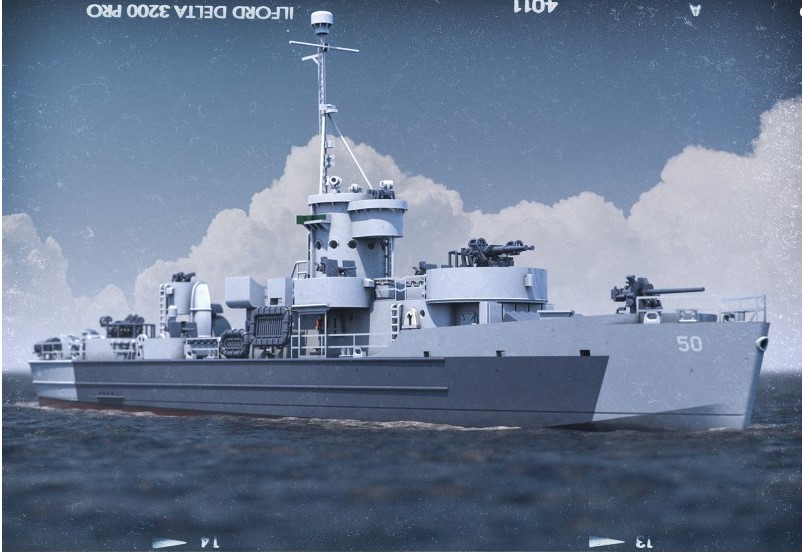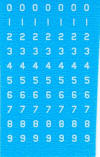1/350 Landing Craft Support Large LCL(L)


|
by Martin J Quinn |
|
| HISTORY | |
| The Landing Craft, Support (Large) were two distinct
classes of amphibious warfare vessels were used by the United States Navy
(USN) in the Pacific and the Royal Navy in World War II. The USN versions
which were later reclassified Landing Ship Support, Large also performed
radar picket duty and fire fighting. The original designation for the ships
was LCS(L)(3), which stood for "Landing Craft Support (Large) Mark 3".
In 1949 the class was reclassified to "Landing Ship Support, Large" (LSSL).
A total of 130 were made. Three different ship building yards did the construction. The hull was the same as the Landing Craft Infantry ships. They were 158 ft 6 in long, displaced 250 long tons, 23 ft 3 in wide and drew 5 ft 10 in when fully loaded. The flat bottom and skegs between and on either side of the twin screws allowed the ships to safely beach. The anchor is at the stern of the ship so it can be used to help pull the ship off the beach if necessary. LCS(L) vessels could be produced in as little as 10 days, and final fitting out would take a further few weeks. The ships also made very good fire fighting ships. A fire fighting manifold was fitted in front of the bow gun and two monitors with pumps fitted just forward of the aft gun. The Battle of Tarawa showed a gap in Navy resources for close in support of landing troops. The time interval between the end of shelling from the large ships and the arrival of the landing craft on the beach allowed the defenders to regroup. The Landing Craft Support was designed to fill this void. The first Landing Craft Support ships arrived in the Pacific Theater in time for the landings at Iwo Jima. After providing close in support during the landings at Okinawa, many Landing Craft Support ships were placed on the radar picket stations as anti-aircraft platforms. When not on a picket stations, the ship would create smoke to hide the fleet at anchor and perform "skunk patrol" screening for suicide boats. In the Borneo Campaign, Landing Craft Support was used in landings in Tarakan and Balikpapan. During World War II, five LCS(L)(3)s were sunk in combat (see below) and 21 were damaged. Three of these small warships received the Presidential Unit Citation, while six were awarded Navy Unit citations. Importantly, Lieutenant Richard M. McCool, skipper of USS LCS(L)(3) 122, was awarded the Medal of Honor. LCS(L)(3)-7, LCS(L)(3)-26 and LCS(L)(3)-49 were sunk by suicide boats off Mariveles, Corregidor Channel, Luzon, Philippine Islands, on 16 February 1945. LCS(L)(3)-15 was sunk by kamikaze aircraft off Okinawa, Ryukyu Islands, on 22 April 1945. LCS(L)(3)-33 was sunk by a kamikaze on 12 April 1945 at RP position No1. For further information, check out the Wikipedia (where this information came from) for LCS(L) vessels here. Other interesting info on these ships can also be found here and here. |
| The
Black Cat LCS(L)
LCS(L) is packaged in the familiar flip top cardboard box, with a nice rendering of the ship underway on the box top. Inside the box is the hull, superstructure and a plastic clamshell container with 3D printed parts. In fact the entire kit is 3D printed. Also included is a small set of photo-etch, some turned brass and a small set of decals. |
|||||||||||||||||
|
|
|||||||||||||||||
| THE HULL | |||||||||||||||||
| As mentioned above, the entire kit
is 3D printed. The hull is one piece on it's own print
raft. Overall, it's crisply printed. Bulwarks, splinter shields,
both with bracing, and the foundation for the bow gun are all printed as
part of the hull. There are also lines printed on the deck to mark
where the deckhouse and other parts are placed.
There are some slight print lines visible, but hopefully these will disappear under coat of paint. |
|||||||||||||||||
|
|
|||||||||||||||||
| SUPERSTRUCTURE | |||||||||||||||||
| The base of the superstructure is one 3D printed part. Splinter shields, some with bracing, and watertight doors are included. As above, there are some faint print lines visible. | |||||||||||||||||
|
|
|||||||||||||||||
| SMALLER 3D PRINTED PARTS | |||||||||||||||||
| The rest of the 3D printed parts are in a plastic clamshell package, secured with double sided tape. There are five print rafts here, with everything you'll need to finish off your LCS(L), including weapons, ladders, conning tower, cable reels, rafts, flag bags, chocks and more. | |||||||||||||||||
|
|
|||||||||||||||||
| BAR A | |||||||||||||||||
| On this print raft we find chocks, bollards, ammo boxes two types of access hatches with handwheels (the handwheels are impressive, IMO), vents, cable reels, fire hoses and what looks like a radar dome. | |||||||||||||||||
|
|
|||||||||||||||||
| BAR B | |||||||||||||||||
| Here we have flag bags, more cable reels & vents, a Mk 51 director tub, the anchor assembly for the stern, the rocket launchers (covered), rudders, and some superb vertical ladders. These ladders are very sharp. | |||||||||||||||||
|
|
|||||||||||||||||
| BAR C | |||||||||||||||||
| The bases for the twin 40mm guns, one piece 20mm guns, Mk 51 directors, winch, anchors and rafts. While everything looks good, the rafts are especially well done. | |||||||||||||||||
|
|
|||||||||||||||||
| BAR D | |||||||||||||||||
| The prominent conning tower is on this print raft. This part really jumps out, with nice detail, including a vertical ladder a very crisp wind deflector, and stairs with molded on railings. Also included are more rafts, the prop shafts with props, a large vent, the 40mm & 3in guns and a ships boat. | |||||||||||||||||
|
|
|||||||||||||||||
| BAR E | |||||||||||||||||
| This is the smallest print raft included, and on it you'll find six signal lamps. These are also very nice, with individual handles on the backs on the lamps. | |||||||||||||||||
|
|
|||||||||||||||||
| TURNED BRASS PARTS | |||||||||||||||||
| A small bag of turned brass parts are included. Included is the mast, yard arms and two supports for the Mk 51 director tubs. | |||||||||||||||||
|
|
|||||||||||||||||
| PHOTOETCH | |||||||||||||||||
| There is one small fret of PE included. Included are railings, vertical ladders (in the event you damage or want to replace the 3D printed versions), supports to hold the rafts and an alternate set of rails for the stairway leading up to the conning tower. | |||||||||||||||||
|
|||||||||||||||||
| DECALS | |||||||||||||||||
| There is one small decal sheet, consisting of small white hull numbers. Some of these vessels carried larger hull numbers. It would have been nice to have seen those larger numbers included. | |||||||||||||||||
 |
|||||||||||||||||
| INSTRUCTIONS | |||||||||||||||||
| The instructions are in Black Cat's
usual styles - a color booklet, with the parts all laid out, and shown
in different colors, for ease of identification. The build
sequences seem to be fairly logical and straightforward, and should be
easy to follow. As mentioned in previous Black Cat reviews,
other manufacturers should take a look at these directions and take note
- this is how you do it!
Included in the instructions are two views of the camouflage worn by some of these vessels. It seems to be a variation on Ms22. Some of these LCS(L)s carried very complex green patterns on them off Iwo Jima and Okinawa (photos included below). I would have liked to have seen those included as painting option, but that's a really nit-picky comment. There are plenty of photos online to use as references if you choose to use one of those camouflage schemes. |
|||||||||||||||||
|
|||||||||||||||||
| CONCLUSIONS | |||||||||||||||||
| While this isn't the first LCS(L)
kit in 1/350, I don't think its a stretch to say this is the best LCS(L)-class
kit available.
Overall, this is a terrific little kit. While there are some faint print lines on the hull and the superstructure, those "should" disappear under a coat of paint, and the smaller parts are really, really well done. This should be a fairly simple and quick build for most modelers, especially if you opt for the simple camouflage scheme shown in the instructions. Highly Recommended! This is an in-box review of Black Cat Models 1/350 Landing Craft Support Large LCL(L), kit number 350-041. The model lists for approximately $45.00 USD, and is available from many of our fine sponsors, or directly from Black Cat Models, who I'd like to thank for the review sample. |
 |
||||||||||||||||
